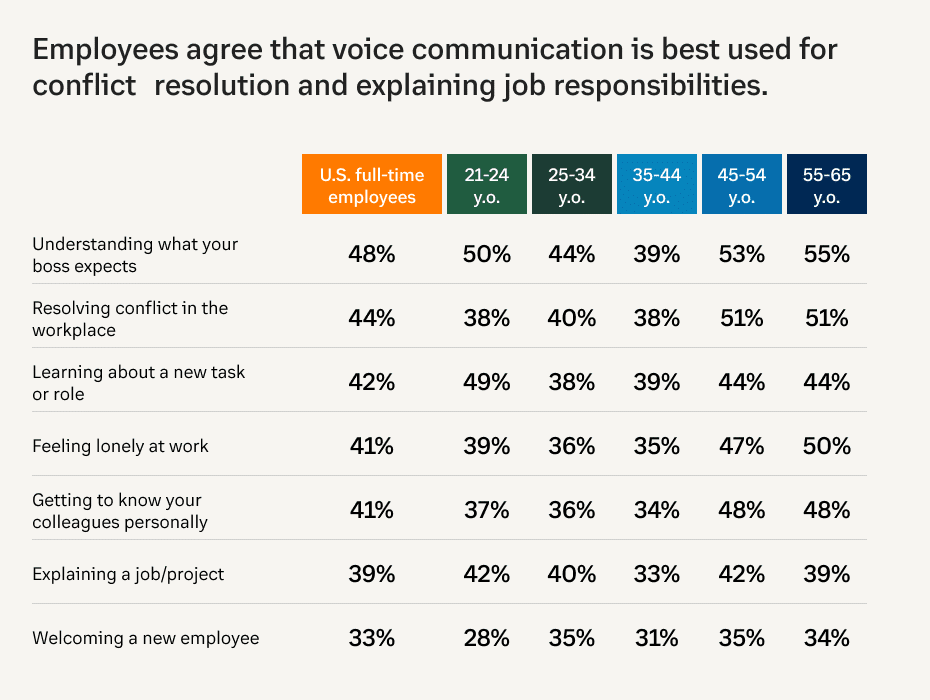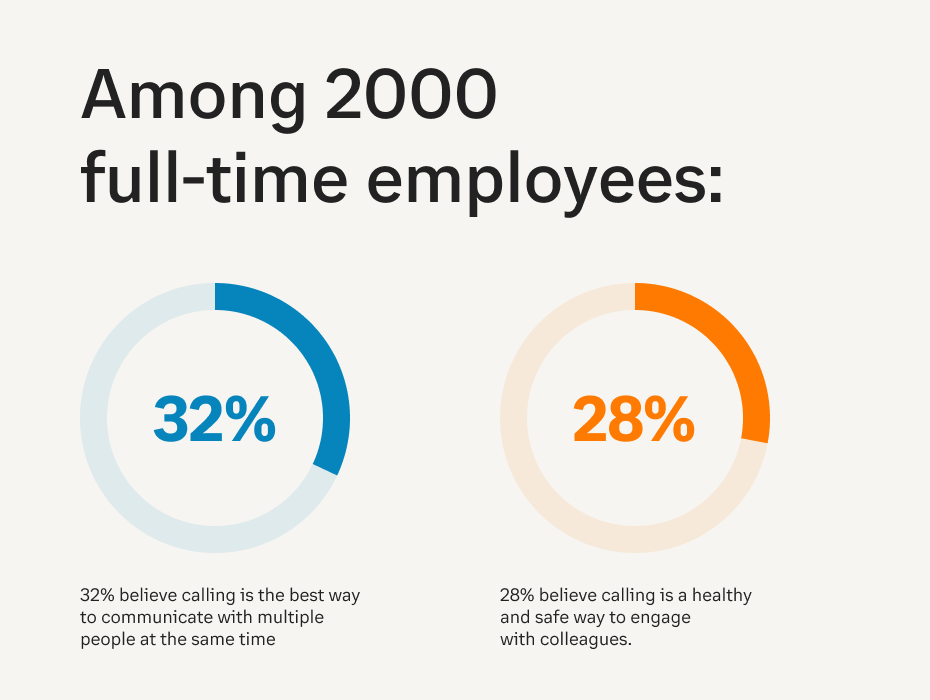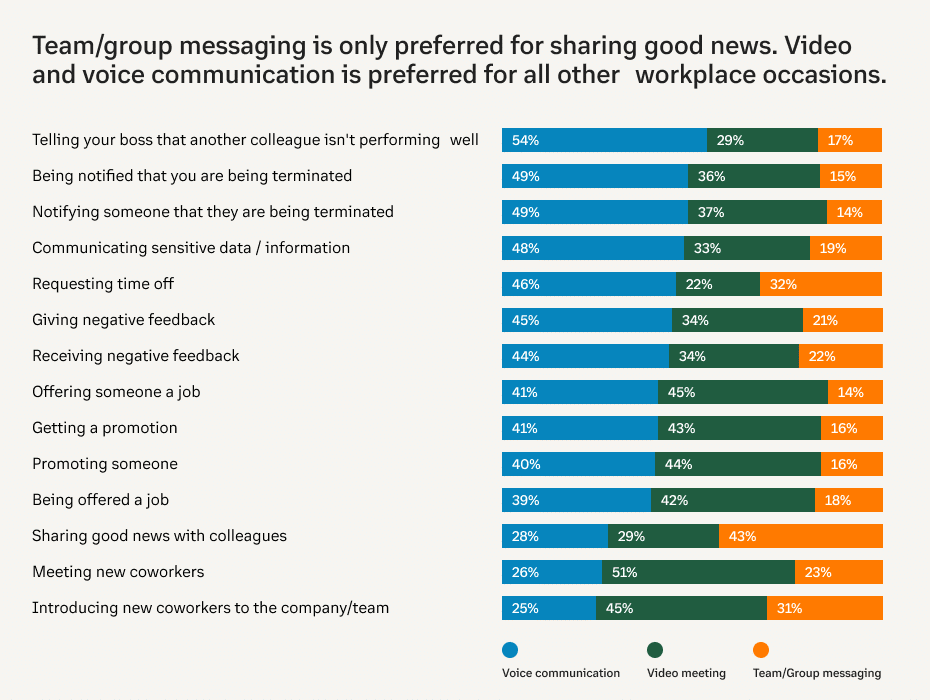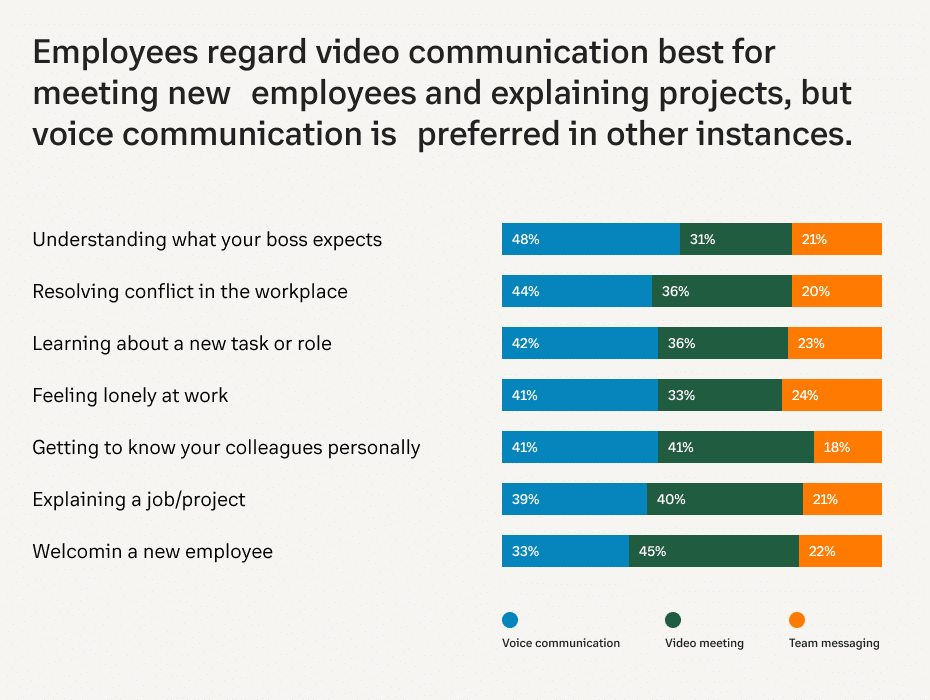Highlights:
- The rise of newer forms of business communications (team messaging, video conferencing) was expected to oust the age-old favorite: phone calls.
- A study conducted by Ipsos and RingCentral found that while messaging and video serve their purposes, calling is still preferred for many reasons.
- Here’s why calling is here to stay in the post-pandemic future of work.
Communication is at the heart of all great teamwork. From your calendar packed full of video meetings to the emails you read every morning, you have so many different ways to communicate with your colleagues and customers.
But while you might assume that messaging and video have eliminated phone calls, the truth is, calling is stronger than ever. In fact, the pandemic saw a resurgence of using phone calls to communicate in the workplace.

Everything you need to know about unified communications. For beginners
We recently surveyed 2,000 full time and part-time workers to talk about connectedness at work. Let’s take a look at the findings.
Voice calling vs. phone
Before we delve into what survey participants in the U.S., Britain, France, and Australia told us about the importance of voice calls in their current work situations, let’s clarify what we mean when we talk about voice vs. phone.
Voice calls refer to VoIP, or Voice over Internet Protocol. These are calls that are delivered over the internet, such as when you make a call with RingCentral or Microsoft Teams. Phone refers to landlines and mobile phones that use old-fashioned calling technology.
Either way, our findings show that when it comes to connecting coworkers—and especially colleagues who work from different locations—nothing else comes close to the power of voice.
1. 80% of employees (including younger workers) say voice beats written communication
Got a question for a colleague or an issue that requires discussion? Voice beats out written modes of communication such as text or email, a whopping 80% of survey participants say.
Approximately eight in 10 also say they’d prefer to have a call to discuss with colleagues when a specific job needs to get done.

Despite a common perception that younger workers tend to shun the phone, high preference for voice actually runs strong across multiple age groups. The same percentage of employees aged 25 to 34 as older workers (aged 55 to 65) said they’d rather have a call to address work that needs to get done (78%).
Only slightly fewer younger workers as older participants (79% vs. 84%) said calling is better for work discussions than text-based communication formats.
2. 43% more full-time employees now say voice calls are their preferred mode of communication compared to before the pandemic
Working from home during COVID-19—followed by a long-term shift to remote and hybrid working arrangements for many full-time employees—has transformed “business as usual”.
How workers communicate, and prefer to communicate, are among the most fundamental changes we’ve seen. Old school modes such as email and in-person communications are falling out of favor, with fewer workers citing these as their preferred methods of communicating compared to a couple of years ago.
Meanwhile, voice calls have made significant gains as workers’ preferred way to communicate, likely due to their accessibility on any device, reliability and call quality, and ability to integrate with other workflows.
3. 25% say there is nothing better than voice apps for connecting multiple people at one time
One-on-one connections are important, but they represent just one of the ways collaborative work gets done these days.
Whether it’s a team discussion or an update to clients, there are many occasions where workers need to talk to multiple people at one time—and in this respect, nothing (not even in-person communication) beats voice apps.

Whether there are three people on a call or 30 (or more), voice-based applications are respondents’ #1 mode for talking as a group, with 25% of those polled citing voice apps as best. This beats out video (12%) and even in-person group discussions (19%).
4. More than 4 in 10 workers say voice is the next best thing to being there for growing connections with colleagues
Even after so much time apart, many workers still place a high value on the emotional power of connecting in person. But that’s not always possible in today’s hybrid and remote world.
When it comes to building a trusted relationship with another colleague and showing empathy and support for coworkers, most employees say nothing beats the power of voice.
Of all the potential modes for communicating remotely, 42% and 44% of respondents respectively cited voice and phone calls as being optimal for building trusted relationships and showing empathy and support for coworkers, beating out methods such as video, messaging, and email.
Voice-based communications also ranked tops for sharing personal stories and reducing loneliness in the workplace, as well as for sending off coworkers before they leave the organization.
5. Voice beats video for difficult conversations
Whether it’s delivering negative performance feedback or terminating an employee, remote and hybrid work means navigating more difficult conversations from disparate locations.
But because of the potential ramifications of these discussions, their delivery method warrants careful consideration. Most workers say a voice call is the best channel for tough talks.

When asked their preferred mode of communication, 54% said voice is best for telling their boss another colleague isn’t performing well, compared to 29% who prefer video and 17% who would rather discuss over team/group messaging.
Workers also expressed a high preference to be notified of termination via voice compared to video or messaging, and expressed similar preferences when it comes to giving and receiving negative feedback.
Nearly half of workers also say they prefer to communicate sensitive data and information by voice compared to other modes, and even prefer voice calls for requesting time off.
6. More than 1 in 4 workers say voice is the best way to get on the same page
The benefits of voice extend far beyond emotional power. Second only to sitting down in person, voice and phone calls were cited as the best way to ease the complexities and confusion that can arise working with others and working remotely.
In our survey, 27% of respondents said voice and phone calls are the best method for understanding how a colleague feels about a specific topic or issue, 24% said voice-based communications reduce confusion in the workplace, and 28% said voice and phone are optimal for understanding the requests of coworkers.
7. Voice is the #1 communication mode for resolving workplace conflict
Without good communication, it’s harder to build connections with colleagues remotely—and conflicts and misunderstandings that can disrupt working relationships may become more likely.

When such breakdowns occur, voice calls are also employees’ preferred way to work things out: 44% of respondents said voice communications are the best way to resolve workplace conflicts, compared to 36% and 20% who would rather hash things out over video or team messaging.
8. 78% say colleagues that use voice communications are more connected to each other
Trust and camaraderie are part of the magic of a great team, and a key ingredient for successful collaboration. These qualities are harder to grow when everyone works from a different location, but voice can play an important role, survey respondents say.
Nearly eight in 10 workers agree that colleagues who use voice communications are more connected to each other—strong findings that were consistent across all age groups.
Originally published Dec 13, 2021
Looking For Startup Consultants ?
Call Pursho @ 0731-6725516
Telegram Group One Must Follow :
For Startups: https://t.me/daily_business_reads







